Considerations in the purchase and set-up of a sound room
The key factors in the successful selection of a sound room are:
1) Determining your working space based upon application;
2) Creating customer comfort through appearance upgrades; and
3) Having realistic expectations of product noise reduction, cost, and performance.

|
is manager of product management for ETS-Lindgren LP, the parent company of Acoustic Systems, Austin, Tex. |
The modern hearing test environment is the hallmark of a professional hearing care business, and the space that defines the unique character of professional services provided to our clientele. The test environment is often the epicenter of a clinic or dispensing practice. In the eyes of the customer, the exam room supplies a certain element of mystique. The sound room is identified as a special space with necessary quiet properties where hearing assessments and hearing aid fittings are often conducted.
In addition to the sound room’s significance as “ground zero” of the hearing care industry, it also serves as the primary space where customers spend a good deal of time inside during their interaction with the professional. It makes sense, therefore, to create a modern space that reflects the high-tech nature of assessments, as well as the high-tech nature of today’s hearing aids. The space should provide a comfortable experience for the customer that projects the expertise and professionalism of the provider they have selected.
Jim Pehringer, AuD, a practicing audiologist from Minnesota, says, “I think that it is important that the test environment offer a pleasant, well lit, comfortable space that makes the patient feel at ease during the testing as opposed to a trapped feeling in a poorly lit room from which they cannot wait for the procedure to be over so they can escape!” Pehringer also recommends that the selection of carpet color, wall enhancements, lighting fixtures all contribute to the “experience” and overall impressions of the practice. A neat arrangement of test equipment is essential to conveying an image of a high tech clinic.
In other words, a test suite should be clean, neat, well lit, and professional.
Selecting a Modern Test Suite
There are nine key purchasing criteria to consider at the early design phase of any audiometric test environment construction or installation project. These criteria are all inter-related:
1) Working space. Whether your concentration is on retail dispensing, private practice dispensing, diagnostics, or research, there is a good chance that a significant amount of your (and your colleagues’) working life will revolve around the sound room. You need to carefully consider how the sound room can be physically situated in your particular facility so that it provides exceptional access and maximizes workflow relative to the professionals and patients (and their family/friends), as well as technicians/assistants and administrative personnel.
2) Application. What tests will be conducted in the sound room and who will be your patients? If you will be using the room strictly for standard audiometric assessments (air/bone thresholds, word recognition, speech/tone MCL/UCLs, etc) with adults, you will probably have a simpler specification than a private practice owner, researcher, or diagnostic audiologist who plans on doing a large battery of tests, including soundfield.
3) Customer comfort. Although this may seem like an obvious criteria, special considerations should also be made in the cases of children and special-needs individuals who may have a wide range of disabilities. Additionally, people are generally not accustomed to a low noise/reverberation environment, and it can elicit discomfort, especially in smaller test rooms with limited windows or low lighting.
4) Required noise reduction. How much noise reduction do you need in your office and how quiet does your sound room need to be? This topic is discussed in greater detail below.
5) Cost. How much are you willing to pay for a sound room and how important is noise reduction during testing and fitting to your overall business?
6) Aesthetics. The physical appearance of the sound room is important and makes a difference in the patient’s perception of your business. If you are addressing the “complete patient experience,” then your office’s sound room certainly figures into this equation.
7) Size of the test room. This not only takes into account the factors mentioned in items 1 and 2 (workspace and application), but is also restricted by the physical size of your office building or practice.
8) Weight. In some cases, there will be weight restrictions and considerations relative to the load-bearing characteristics of your office’s floors.
9) Conformance with local codes. The system needs to comply with local building and safety codes.
The three top variables—workspace, application, and customer comfort—are directly related to one another, and should weigh heaviest in your decision. In comparison, the six other factors (with the possible exception of required noise reduction) might be considered “limiters” or “preferences.” All things considered, the type of office/practice you have will help shape the required amount of workspace required, and the type of application (screening tests, diagnostic evaluation, pediatric assessment, hearing aid fitting, research, etc) will guide your decision on how large and complex an environment you will need to create.
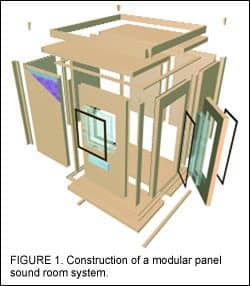
|
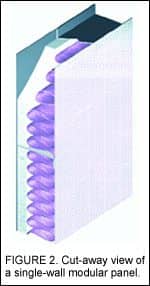
|
Noise Reduction
Obviously, the noise reduction variable is a critical element in any purchase decision involving a sound room. Reliable test results depend upon low ambient noise levels within the test space. The American National Standards Institute (ANSI) specifies maximum permissible ambient noise levels (MPANL) allowed in audiometric test environments. These MPANLs help to ensure that hearing thresholds obtained down to 0 dB HL will not be elevated due to the masking effect of ambient noise. MPANLs were originally specified in 1960, and have been revised in 1977, 1991, and most recently in 1999 (ANSI S3.1-1999).1
The 1999 MPANLs are specified in octave and one-third octave band intervals for two audiometric testing conditions: ears covered (eg, patient with headphones) and ears not covered (eg, patient in soundfield). The MPANLs are defined for three test frequency ranges: 125 Hz to 8000 Hz, 250 Hz to 8000 Hz, and 500 Hz to 8000 Hz. ANSI S3.1-1999 affects all individuals testing hearing, as well as distributors, installers, designers, and manufacturers of audiometric test environments.2,3
One of the most common questions asked during the design phase of selecting an audiometric test room is “How quiet will it be in the test room?” There is no easy answer to this question because each installation is unique and the final result relies on a combination of interacting factors. The host building and its systems and uses will have characteristic ambient sound pressure levels (SPL) linked to its design, construction, and location. Consideration must also be given to vibrations in the host building slab or floors, energy transfer from walls and windows, and the contributions of energy from the heating and air conditioning (HVAC) systems. These are the primary external variables that can influence the effectiveness of the soundproofing.
The internal variables affecting chamber “quietness” include the noise created by chamber systems (eg, ventilation) and the noise floor potentially introduced by test equipment located within the test environment, like audiometric equipment, computer fans, etc.
|
Acoustic Design Considerations |
|
|
In My Sound Room? |
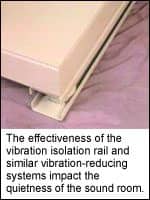
|
Before we can answer the question about how quiet it will be in the test environment, we need to determine the SPLs of the installation site. Early in the design and selection phase, it is important to conduct a sound survey of the host site. Manufacturers of test enclosures often provide detailed questionnaires to help you evaluate locations for your test suite. It may also be advantageous to have an acoustical consultant provide a sound-level study, collecting measurement data of SPLs and vibrations.
As a rule of thumb, remember that the sources of noise or vibration occur within the designated space for the test environment, in adjacent spaces, plus the potential contribution of spaces above and below the intended host location. Sampling at various times/days may be key to discovering noise and vibration sources. This is particularly true in mixed-use buildings such as retail shopping complexes and multi-story office towers. For example, if a new dry cleaning business with noisy machinery bolted to the building slab replaces the accountant’s office that was the previous occupant of the office space adjacent to your practice, both you and your sound room will face some unforeseen host-site ambient noise/vibration challenges. If you are a tenant in a mixed-use building, check with the property management company to learn what use is permitted. Your quiet neighboring tenant today may become a noise generating one tomorrow!
Noise Reduction of Typical Commercial Sound Rooms
According to Jeff Schmitt, PE, an acoustical consultant and president of Viacoustics, Austin, Tex, noise reduction is a property of the entire enclosure system. “Noise reduction is defined as the difference between the SPL outside of the test environment enclosure and the SPL inside of the enclosure when tested with a sound source present (ambient external noise vs. ambient internal noise),” Schmitt says. “Noise reduction depends upon the sound transmission properties of the enclosure components and the sound absorption properties inside the enclosure.” It is the key specification for the sound isolation properties of the audiometric test room.”
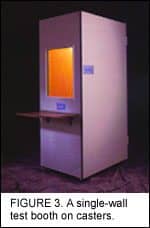
|
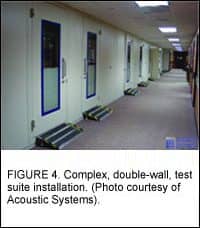
|
Standard construction techniques such as concrete or stud walls with insulation are not the preferred choice in the field for audiometric testing. Although many have tried to achieve the noise reduction of today’s modular panel systems, you would need to create expensive and inefficient thicknesses to provide the level of sound isolation achievable with commercially available modular panels.
Table 1 shows the reduction data for two types of modular enclosures. Clearly there is significant additional noise reduction for double wall enclosures when compared to a single wall portable product. For clinicians and researchers, this level of precision is required for their test applications. For general-purpose threshold audiometry in a reasonably quiet office/host site, single wall modular systems can be quite effective.
During product selection, the site survey data becomes important in determining the thickness of panels, and whether a single wall system is adequate or a double wall system is required. The formula for determining this is outside noise level minus the effectiveness of the enclosure, which yields the internal soundbooth measured SPL.
Consistency
Scott Dunlap of Acoustic Systems, Austin, Tex, says they use standard components and modular construction techniques to manufacture all their sound isolating products in order to provide predetermined, laboratory-verified, acoustical performance levels from standard component designs (Figure 1). “Purpose-built, modular systems make it easy to integrate test equipment via shielded, acoustical penetrations through walls for USB, Ethernet, standard jacks and other connections,” Dunlap says.
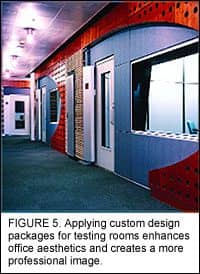
|
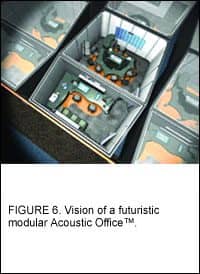
|
Figure 2 shows a cut-away view of a manufactured, modular panel designed for use in a medical/life science test environment. Each panel of this system is produced under quality-controlled conditions so that a consistent acoustic shielding effect is achieved. The exterior of the panel is solid steel, with a dense gypsum layer laminated to the steel and a non-fiberglass woven layer, encapsulated by a perforated inner skin.
Figures 3 and 4 show how various, pre-defined panels, doors, windows, and ventilation systems can be combined into a test environment matched to the host site. When specifying your new test environment, it’s best if your supplier verifies component performance in an NVLAP-accredited laboratory and measures in accordance with ASTM E-596.
Moving Forward: Bringing the Real World Into the Sound Room
As the level of style and design becomes an important factor in customer comfort and satisfaction, the cosmetic design of your test environment projects an impression on visitors. Multi-unit retail hearing aid dispensing businesses and new medical centers are creating design themes and standards of appearance not seen previously in this field (Figure 5).
For example, Kasewurm4,5 has detailed an office set-up that facilitates a patient-driven protocol and virtual-reality fitting rooms in a salon-like atmosphere (a 360° virtual office tour is offered at www.prohear.net). It is easy to see how these types of protocols may one day be routinely integrated into room designs. By engaging the patient and involving them throughout the selection and fitting process, a higher level of patient ownership of the hearing problem (and loyalty) and higher customer satisfaction rates are achieved.
Revit6 has shown that there is a need for accurate, valid, real-world assessment of hearing aid systems, and one way to achieve this is through multi-loudspeaker simulations that are designed to standardize assessment and validation outcomes of hearing aids. The R-SPACE system consists of eight speakers placed around the patient in a soundfield in order to closely replicate listening situations in the real world. Although its current application may be primarily within the research area of our field, the advantage of these types of systems are readily apparent in a sound booth. A number of other “simulation systems” have been detailed in the literature,7-10 and this issue of HR includes several examples (see the articles by Howe; Beck & McGuire; and the interview with Bill Cole).
The future of hearing health care delivery and the sophistication of the generation of customers we are about to serve expects and demands beauty, comfort, and function in the facilities they visit for their healthcare needs. The hearing health care test and fitting environment of the future will likely look more like the interior of a modular studio with acoustic treatment and noise reduction (Figure 6) rather than the “test chambers” we know today.
Getting Started
If you are considering the installation or creation of a modern audiometric test environment, one place to begin is by seeking the assistance of a qualified reseller with trained sales, service, and installation technicians. In the United States, a valuable resource is the National Association of Special Equipment Distributors (www.nased.com). The key factors to a successful installation are 1) Determining your working space based upon application; 2) Creating customer comfort through appearance upgrades; and 3) Having realistic expectations of product noise reduction, cost, and performance.
Acknowledgements
The author thanks James Pehringer, AuD, president of Pehratek Products, Chaska, Minn, makers of wireless remote controlled VRA systems, and Jeff G. Schmitt, PE, president of Viacoustics, Austin, Tex, an acoustical consulting firm, for their special contributions to this article.
References
1. American National Standards Institute. Maximum Permissible Ambient Noise Levels for Audiometric Test Rooms (S3.1 1999). Washington, DC: American National Standards Institute; 1999.
2. Berger EH. Options in Defining Background Noise During Audiometric Testing. CAOHC Update. 2006;18(1).
3. Frank,T. ANSI update: Maximum permissible ambient noise levels for audiometric test rooms. Amer Jour Audiol. 2000;9(1).
4. Kasewurm G. A multimedia fitting tool for a patient-driven protocol. The Hearing Review. 2004;11(11):40-42.
5. Kasewurm G. Creating the ultimate patient experience. Hear Jour. 2003;56(10):48-50.
6. Revit LJ, Schulein RB, Julstrom SD. Toward accurate assessment of real-world hearing aid benefit. The Hearing Review. 2002;9(8): 34-38,51.
7. Pehringer JL. Fine-tuning hearing instruments using an economical sound simulator. The Hearing Review. 2005;12(6): 50-52.
8. Meskin M, Robinson J. A patient-focused approach to fitting hearing instruments. The Hearing Review. 2000;7(12): 52-55.
9. Robinson J, Russ D, Siu B. Effect of multimedia fitting tool on final gain settings. The Hearing Review. 2002;9(3): 42-45.
10. Kuk F, Bulow M, Damsgaard A, Jessen A, Ludvigsen C. Hearing aid fittings and the use of simulated sound environments. The Hearing Review. 2004;11(8):42-48.
Correspondence can be addressed to HR or Brian J. Hill, ETS-Lingren LP, 1301 Arrow Point Dr, Cedar Park, TX 78613; Web site: www.ets-lindgren.com or www.acousticsystems.com; e-mail: [email protected].





